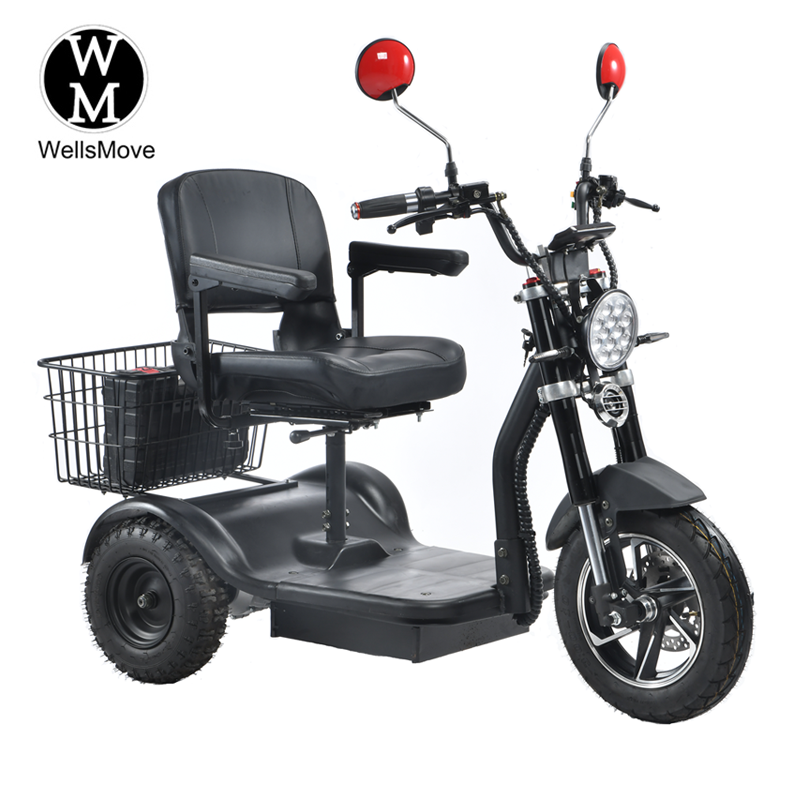Analysis of the Frame Welding Process for Senior Three-Wheeled Scooters
For senior three-wheeled scooters, the frame is not only the “skeleton” supporting the vehicle but also the “first line of defense” for elderly users’ safety. The welding process, a core step in frame manufacturing, directly determines the frame’s structural strength, stability, and service life. This article will deeply analyze the key points of the welding process for senior three-wheeled scooters from three perspectives: technical selection, quality control, and performance advantages. This will help users understand the safety value behind this “invisible process.”
I. Why is the welding process for senior three-wheeled scooters “unique”?
Senior users’ core demands for mobility scooters focus on safety, stability, and comfort. This requires the frame welding process to exceed the standards of ordinary mobility scooters and meet more demanding usage scenarios:
Special load-bearing requirements: Elderly users may carry personal belongings when traveling, and the frame must continuously withstand the dual pressures of “human body + load.” Welds must be fatigue-resistant to prevent cracking after long-term use.
High adaptability to road conditions: Elderly users often travel on non-standard surfaces such as residential roads and around markets. Bumps and vibrations repeatedly impact the frame structure, requiring welds to possess sufficient toughness to prevent fracture.
Long service life: Elderly mobility scooters are often used for long periods of time. The frame lifespan must match the user’s needs, and the welding process must eliminate the problem of “short-term durability and long-term failure.”
Based on these requirements, the frame welding process for elderly three-wheeled mobility scooters requires a precise balance between strength and toughness, ensuring structural stability while avoiding fragility caused by excessive rigidity.
II. Analysis of Core Welding Technologies for Elderly Tricycle Frames
Currently, mainstream elderly tricycle frames are mostly made of low-carbon steel or high-strength alloy steel. Differentiated welding techniques are employed to address the stress characteristics of different parts, ensuring that the overall structural performance meets standards. The following are the application scenarios and technical advantages of three core welding processes:
1. Carbon Dioxide Gas Shielded Welding (CO₂ Welding): The “Basic Support” of the Vehicle Frame’s Main Structure
Application Areas: Core load-bearing structures such as the frame’s main beams and longitudinal and transverse support tubes, which must withstand the vehicle’s weight and impact during driving.
Process Principle: Carbon dioxide gas isolates the air, preventing metal oxidation during welding. Continuous wire feeding ensures efficient welding and uniform weld formation.
Technical Advantages:
High Weld Strength: The tensile strength can reach over 400 MPa, far exceeding the load-bearing requirements of ordinary steel, ensuring the frame remains stable under long-term loads.
High Welding Efficiency: Suitable for mass production, while reducing weld defects (such as porosity and slag inclusions) and lowering maintenance risks.
Excellent Low-Temperature Toughness: The weld maintains good toughness even in low winter temperatures, preventing low-temperature brittle cracking and making it suitable for use in cold northern regions.
2. Argon Arc Welding (TIG Welding): Detail-Guarding Precision Components
Application Areas: Precision components such as the frame-seat connection, steering mechanism attachment points, and battery compartment brackets. The welding accuracy of these components directly impacts ride comfort and operational safety.
Process Principle: Argon is used as the shielding gas, and a tungsten electrode is used. Arc heating melts the metal, resulting in spatter-free welding and a delicate weld.
Technical Advantages:
High Welding Precision: The weld width tolerance can be controlled within ±0.5mm, ensuring precise assembly of precision components and preventing seat shake and steering jamming caused by welding misalignment.
Excellent Surface Quality: The weld seam is smooth and level, with no noticeable protrusions or depressions, minimizing the risk of scratches for elderly users when getting in and out of the vehicle.
High Corrosion Resistance: TIG welds exhibit low oxidation resistance. Combined with a post-painting treatment, they effectively resist corrosion from rain and humid environments, extending the service life of the vehicle frame.
3. Resistance Spot Welding: A Balanced Choice Between Lightweight and Strength
Application Areas: Connections between vehicle frame side panels, trim components, and the main structure. These areas do not bear core loads, but require a balance between lightweight and stable connections.
Process Principle: Pressure is applied through electrodes, and the resistance heat generated by the current locally melts the metal, forming a weld point. No filler material is required during the welding process.
Technical Advantages:
Significant Lightweighting: Compared to traditional welding, resistance spot welding requires no additional welding wire, reducing overall frame weight, lowering vehicle fuel consumption, and extending range.
Excellent Sealing: Tightly fitting welds effectively prevent rainwater from seeping into the frame, preventing internal metal corrosion.
No Deformation Risk: The localized heating area is small, minimizing thermal deformation of the frame components after welding, ensuring a smooth vehicle appearance.
III. Welding Process Quality Control: The Essential Path from “Process” to “Qualified”
High-quality welding processes rely not only on technical selection but also on a comprehensive quality control system. Reputable manufacturers of three-wheeled mobility scooters for seniors establish strict standards for welding before, during, and after welding to ensure the quality of each frame:
Steel Screening: Low-carbon steel or alloy steel that meets national standards is selected. Material certification is required for each batch of steel, and key indicators such as tensile strength and yield strength are tested.
Surface Pretreatment: Before welding, oil, rust, and scale are removed from the steel surface. Sandblasting or pickling is performed to ensure a tight metal bond and minimize weld defects.
Welding Parameter Setting: Customized parameter tables (such as current, voltage, and welding speed) are developed based on steel thickness and welding location. Professional welders conduct test welds to confirm the parameters before mass production begins.
2. Welding: Process Monitoring and Operational Standards
Welder Qualification Certification: All welders must hold a nationally recognized welding operator’s certificate and have at least three years of frame welding experience and be familiar with the welding difficulties of mobility scooter frames.
Real-time Monitoring: Key welding stations are equipped with high-definition cameras to record the welding process for easy traceability. Temperature sensors are also used to monitor the welding area to prevent degradation of steel properties due to excessive temperatures.
Defect Prevention: The welding gun nozzle is regularly cleaned during welding to prevent clogging by spatter. For every ten frames welded, one weld is randomly selected for visual inspection to identify problems such as porosity and cracks.
3. Post-Welding: Inspection and Strengthening Treatment
Appearance Inspection: All welds must be inspected visually and with a magnifying glass. The welds must be smooth, free of cracks and slag inclusions, and the undercut depth must not exceed 0.5mm.
Non-destructive Testing: X-ray or ultrasonic testing is performed on key areas such as the frame’s main beam and steering connection points to identify hidden internal defects and ensure that the welds are 100% free of internal cracks.
Strengthening Treatment: After welding, stress relief annealing is performed to eliminate internal stress generated during welding and prevent deformation of the frame due to stress release after long-term use. Welds are also polished and painted to enhance corrosion resistance and appearance.
Fourth, How Can Welding Processes Improve the Travel Experience for Elderly Users?
High-quality welding technology isn’t intangible; it directly impacts the safety and comfort of elderly users through their actual use:
Improved Safety: High-strength welds prevent the frame from breaking during emergency braking or minor collisions, reducing the risk of accidents. For example, when a mobility scooter encounters a bump on the road, the welds on the main frame beam can withstand the instantaneous impact, preventing deformation and loss of control.
Improved Stability: Precision-welded steering and seat connections reduce vibration and noise during driving, providing a smoother ride for elderly users and reducing discomfort caused by bumps.
Extended Durability: Corrosion- and fatigue-resistant welds extend the life of the frame. Most high-quality mobility scooter frames can last for over five years without welding failures, reducing repair costs and hassles for users.
Lightweight Advantages: Processes like resistance spot welding maintain strength while reducing frame weight, making the scooter lighter and more maneuverable for elderly users, especially when turning and parking.
Conclusion: When choosing a three-wheeled mobility scooter for seniors, pay attention to the “invisible craftsmanship”
The safety of a three-wheeled mobility scooter for seniors depends not only on its exterior design and braking system, but also on the “invisible foundation” of the frame welding process. When choosing a product, users are advised to pay attention to the manufacturer’s welding process standards and quality inspection procedures. If necessary, review the product’s welding inspection report to ensure that every weld meets safety requirements.
Post time: Sep-26-2025



